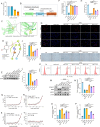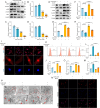Lactic acid promotes nucleus pulposus cell senescence and corresponding intervertebral disc degeneration via interacting with Akt
- PMID: 38212432
- PMCID: PMC11071984
- DOI: 10.1007/s00018-023-05094-y
Lactic acid promotes nucleus pulposus cell senescence and corresponding intervertebral disc degeneration via interacting with Akt
Abstract
The accumulation of metabolites in the intervertebral disc is considered an important cause of intervertebral disc degeneration (IVDD). Lactic acid, which is a metabolite that is produced by cellular anaerobic glycolysis, has been proven to be closely associated with IVDD. However, little is known about the role of lactic acid in nucleus pulposus cells (NPCs) senescence and oxidative stress. The aim of this study was to investigate the effect of lactic acid on NPCs senescence and oxidative stress as well as the underlying mechanism. A puncture-induced disc degeneration (PIDD) model was established in rats. Metabolomics analysis revealed that lactic acid levels were significantly increased in degenerated intervertebral discs. Elimination of excessive lactic acid using a lactate oxidase (LOx)-overexpressing lentivirus alleviated the progression of IVDD. In vitro experiments showed that high concentrations of lactic acid could induce senescence and oxidative stress in NPCs. High-throughput RNA sequencing results and bioinformatic analysis demonstrated that the induction of NPCs senescence and oxidative stress by lactic acid may be related to the PI3K/Akt signaling pathway. Further study verified that high concentrations of lactic acid could induce NPCs senescence and oxidative stress by interacting with Akt and regulating its downstream Akt/p21/p27/cyclin D1 and Akt/Nrf2/HO-1 pathways. Utilizing molecular docking, site-directed mutation and microscale thermophoresis assays, we found that lactic acid could regulate Akt kinase activity by binding to the Lys39 and Leu52 residues in the PH domain of Akt. These results highlight the involvement of lactic acid in NPCs senescence and oxidative stress, and lactic acid may become a novel potential therapeutic target for the treatment of IVDD.
Keywords: Akt; Intervertebral disc degeneration; Lactic acid; Nucleus pulposus cell; Oxidative stress; Senescence.
© 2024. The Author(s), under exclusive licence to Springer Nature Switzerland AG.
Conflict of interest statement
The authors declare no conflicts of interest.
Figures









Similar articles
-
Cartilage endplate stem cells inhibit intervertebral disc degeneration by releasing exosomes to nucleus pulposus cells to activate Akt/autophagy.Stem Cells. 2021 Apr;39(4):467-481. doi: 10.1002/stem.3322. Epub 2021 Jan 18. Stem Cells. 2021. PMID: 33459443 Free PMC article.
-
Genkwanin alleviates intervertebral disc degeneration via regulating ITGA2/PI3K/AKT pathway and inhibiting apoptosis and senescence.Int Immunopharmacol. 2024 May 30;133:112101. doi: 10.1016/j.intimp.2024.112101. Epub 2024 Apr 18. Int Immunopharmacol. 2024. PMID: 38640717
-
[Fibulin-3 Regulates Tissue Inhibitor of Metalloproteinases 3 to Inhibit Senescence in Intervertebral Disc Nucleus Pulposus Cells].Sichuan Da Xue Xue Bao Yi Xue Ban. 2024 Sep 20;55(5):1217-1225. doi: 10.12182/20240760604. Sichuan Da Xue Xue Bao Yi Xue Ban. 2024. PMID: 39507955 Free PMC article. Chinese.
-
Cellular senescence - Molecular mechanisms of intervertebral disc degeneration from an immune perspective.Biomed Pharmacother. 2023 Jun;162:114711. doi: 10.1016/j.biopha.2023.114711. Epub 2023 Apr 20. Biomed Pharmacother. 2023. PMID: 37084562 Review.
-
ASIC1a mediated nucleus pulposus cells pyroptosis and glycolytic crosstalk as a molecular basis for intervertebral disc degeneration.Inflamm Res. 2025 Jan 28;74(1):29. doi: 10.1007/s00011-025-02003-w. Inflamm Res. 2025. PMID: 39870819 Review.
Cited by
-
PKM2-Driven Lactate Overproduction Triggers Endothelial-To-Mesenchymal Transition in Ischemic Flap via Mediating TWIST1 Lactylation.Adv Sci (Weinh). 2024 Dec;11(47):e2406184. doi: 10.1002/advs.202406184. Epub 2024 Oct 30. Adv Sci (Weinh). 2024. PMID: 39474980 Free PMC article.
-
GNF-5837 alleviates intervertebral disc ageing by upregulating glutathione peroxidase 7.Int J Immunopathol Pharmacol. 2025 Jan-Dec;39:3946320251343365. doi: 10.1177/03946320251343365. Epub 2025 Jun 6. Int J Immunopathol Pharmacol. 2025. PMID: 40474606 Free PMC article.
-
The role of micronutrients and serum metabolites in intervertebral disk degeneration: insights from a Mendelian randomization study and mediation analysis.Front Nutr. 2024 Oct 21;11:1428403. doi: 10.3389/fnut.2024.1428403. eCollection 2024. Front Nutr. 2024. PMID: 39498405 Free PMC article.
-
Analysis of Nicotine Toxicity and Mechanisms of Senescence in Nucleus Pulposus Cells Using Network Toxicology and Molecular Docking Technique.JOR Spine. 2025 Mar 31;8(2):e70055. doi: 10.1002/jsp2.70055. eCollection 2025 Jun. JOR Spine. 2025. PMID: 40171441 Free PMC article.
-
The PKM2 activator TEPP-46 suppresses cellular senescence in hydrogen peroxide-induced proximal tubular cells and kidney fibrosis in CD-1db/db mice.J Diabetes Investig. 2025 Apr;16(4):598-607. doi: 10.1111/jdi.14397. Epub 2025 Jan 22. J Diabetes Investig. 2025. PMID: 39840670 Free PMC article.
References
-
- Urban J, Smith S, Fairbank J (2004) Nutrition of the intervertebral disc, Spine, 29(23):2700-9, 10.1097/01.brs.0000146499.97948.52 - PubMed
-
- Holm S, Maroudas A, Urban J, Selstam G, Nachemson A (1981) Nutrition of the intervertebral disc: solute transport and metabolism, Connective tissue research, 8(2):101–19, 10.3109/03008208109152130 - PubMed
-
- Radek M et al (2016) Assessing the correlation between the degree of disc degeneration on the Pfirrmann scale and the metabolites identified in HR-MAS NMR spectroscopy, Magnetic resonance imaging, 34(4):376–80, 10.1016/j.mri.2015.12.005 - PubMed
MeSH terms
Substances
Grants and funding
LinkOut - more resources
Full Text Sources
Research Materials

